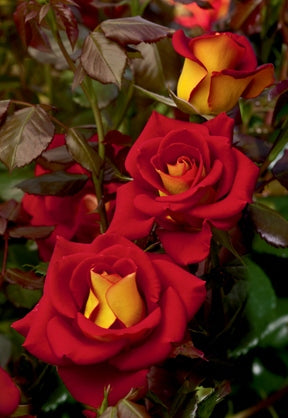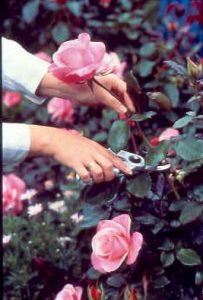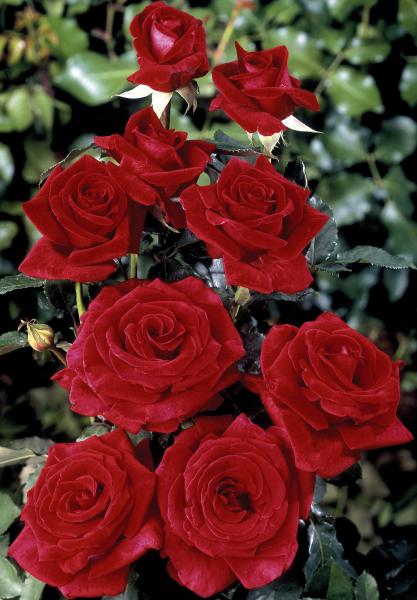 Soil begins to thaw and the first shipment of rose bushes has arrived at garden centers, so we know that the planting season is here! Over 150 roses arrived this week at our garden center, and in just a matter of days shrub roses and the David Austins will be filling our displays. These first of the season rose bushes are not in bloom, which is good news as it is best to get them into the ground before any more leaf buds come out of dormancy.
Soil begins to thaw and the first shipment of rose bushes has arrived at garden centers, so we know that the planting season is here! Over 150 roses arrived this week at our garden center, and in just a matter of days shrub roses and the David Austins will be filling our displays. These first of the season rose bushes are not in bloom, which is good news as it is best to get them into the ground before any more leaf buds come out of dormancy.
This is the time to add roses to our landscapes. If you have tried growing roses in other parts of the country, failed, and given up, you’re in for a surprise. We grow exceptional roses in the mountains of Arizona, and doing so is easier than you might think.
There are only a few steps to the perfect rose bush and it all starts with the annual spring pruning. The next few weeks are ideal for cutting back and thinning local rose bushes. Here are five steps to guide you through the process.
Step #1 – cut out all dead canes. Make sure you wear a good pair of gloves for this step, as encounters with dead thorns can really hurt. This is your opportunity to invest in a new pair of rose gloves specifically designed for the task. Having incurred my share of thorn-inflicted battle scars, I highly recommend a good pair of rose gloves!
Step #2 – cut off wild looking canes and any crossing branches. Usually wild canes grow from below the graft, close to the ground. You don’t want them on your bushes so cut them back to the graft. They are the branches that are heavier with sharper thorns than any others on the rest of the bush. Crossing branches are any that are growing across other branches, contradicting the overall shape of the bush.
 Step #3 – cut out old canes. These are canes that have bark starting to form on them and are very thick, an inch or more in diameter. For this job I break out my favorite pair of long-handled pruners; they’re perfect for the job. These are specialty pruners that allow you to reach well into each bush without having to feel your way gingerly past vicious thorns. You will find this type of pruner only at a garden center. Cutting out these old canes will open up the bush and contribute to the structure of the plant.
Step #3 – cut out old canes. These are canes that have bark starting to form on them and are very thick, an inch or more in diameter. For this job I break out my favorite pair of long-handled pruners; they’re perfect for the job. These are specialty pruners that allow you to reach well into each bush without having to feel your way gingerly past vicious thorns. You will find this type of pruner only at a garden center. Cutting out these old canes will open up the bush and contribute to the structure of the plant.
Step #4 – prune out any canes that have suffered winter damage. They are green at the bottom and red-to-purple-colored on the top; this coloration indicates that the canes have been injured by frost. The goal is to end up with a bush that is knee to waist high, with 3 to 6 canes, in a balanced spacing coming from the main graft near the ground.
Step #5 – seal any cut cane that is larger around than a pencil. This will keep bugs from burrowing into the exposed soft wood. Look for black pruning paint that comes in a can with a small brush attached to the cap; it makes this job really easy.
Now that your pruning is finished for another year, you should wind up your session with a little spring cleaning. Remove any dead leaves and flowers from around the graft so the air can circulate freely around the base of each plant. If you had problems with powdery mildew on certain bushes, make sure you pull all remaining leaves off the canes and really clean up thoroughly. This will reduce the possibility of mildew returning.
Mildew was bad last year, so make sure not to miss this step. Spray the newly pruned rose bush with ‘Infuse’. This super-concentrated liquid spray cleans the remaining bush of any powdery mildew, black spot, and other disease.
Feed your completed roses with a good “Rose Food with a Systemic Insecticide” to encourage new flowers and reduce aphid and thrip damage this spring. The plant actually absorbs the bug killer into its foliage to keep bugs at bay.
~~ ~~ ~~ ~~ ~~ ~~ ~~
The garden center has two exciting new rose introductions waiting to be taken to their permanent homes. They are so ready to flush new growth that flower buds can almost be imagined on these vigorous, healthy roses.
 Fire Fighter – finally we have a nice fragrant red rose! Each five-inch flower is huge because it has twice the petal count of other varieties. This traditional rose bush is robust, bushy, upright, and is the very first rose sponsored in the ‘Remember Me’ garden to honor the victims of 9-11. How apropos that this rose finds itself in Arizona after the loss of last year’s fire fighting heroes. A deep red flower with a fragrance that fills its surrounding landscape, it is the ideal shrub to plant in honor of those we love.
Fire Fighter – finally we have a nice fragrant red rose! Each five-inch flower is huge because it has twice the petal count of other varieties. This traditional rose bush is robust, bushy, upright, and is the very first rose sponsored in the ‘Remember Me’ garden to honor the victims of 9-11. How apropos that this rose finds itself in Arizona after the loss of last year’s fire fighting heroes. A deep red flower with a fragrance that fills its surrounding landscape, it is the ideal shrub to plant in honor of those we love.
Pope John Paul II – a rose that truly personifies the Pope. Whether or not your garden is Catholic, this rose is the finest, most fragrant white flower of all time. In every flower show entered this hybrid tea has received top ratings for vigorous growth, bushy full habit, disease resistance, abundance of flowers, and perfect flower form. The Pope John Paul II produces luminous pure white blossoms with a fresh citrus fragrance. Twice the size of most rose blooms, the lavish petals seem to shine against the abundance of dark green foliage. From late May through autumn this spectacular white rose will dominate center stage wherever it’s planted.
~~ ~~ ~~ ~~ ~~ ~~ ~~
Gardening Class on Saturday, February 22 starts at 9:30, and is entitled “Raised Bed Gardening Best Practices”. Sedona landscape designer, Rich Olson, is back to help teach this class on the right materials, placement, and soil that turns gardening from frustration to a true delight. As usual, there is no charge for this 9:30 a.m. class. Let this class help you to ‘Learn, Grow, Love’ your garden as it rises above the rocks and boulders in your yard.
Until next week, I’ll see you in the garden center.


Do you not give Watters Dollars anymore? We just spent $58 and didn’t get any? Thanx.